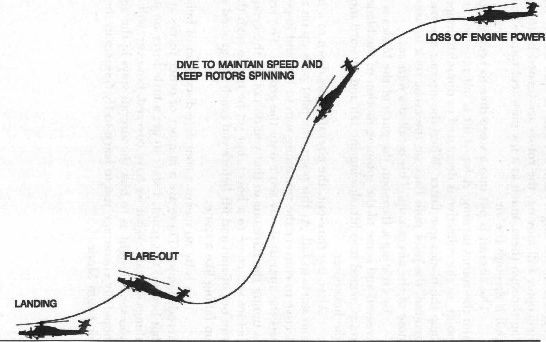Gunship Academy
by Richard Sheffield
Autorotation
When an airplane loses engine power, it can trade altitude for speed and glide for a short distance and land. A helicopter pilot can perform a similar maneuver known as autorotation. An aircraft high in the air has a gravitational pull on it which creates a potential energy. This altitude can be traded for speed or kinetic energy by descending. Speed is needed to keep air moving over the wings of an aircraft so they continue to produce lift.

A helicopter's rotors produce usable lift only when spinning. In the event of an engine failure, the blades are disengaged from the engine and are able to spin freely. With the helicopter still moving, the rotors are turned by the air moving through them, much as a toy pinwheel spins when you pull it through the air.
The aircraft is put into a steep dive to keep its speed up and the rotors turning. A lot of lift is not required at this point, so the collective is decreased to diminish drag and help the blades spin faster. When the aircraft approaches the ground, the pilot pulls back on the cyclic stick to bring the nose of the aircraft up. This is called a flare-out.
By creating a flare-out, the pitch of the blades is increased and some of the spinning motion of the blades is transformed into lift, slowing the fall and forward motion of the helicopter.
After the flare-out, the aircraft slows down to a hover and starts to fall. At this point, the pilot pulls up on the collective to convert the remaining spin to lift, and hopefully, lets the aircraft slowly settle onto the ground. The real key is timing the flare-out so that you do not hit the ground before you come to a hover, but yet be not so high that you run out of spin and lift before you reach the ground and end up falling like a stone.
This is by no means a complete discussion of helicopter aerodynamics. There are a number of other forces at work, but beyond this point, I start to get a little fuzzy on just how things operate. What we have covered, however, will allow you some insight as to how the aircraft stays in the air and hopefully encourage you to learn to fly Gunship in the Realistic Flight Mode.
Table of Contents
Previous Section: Cyclic Control
Next Section: The Pilots
